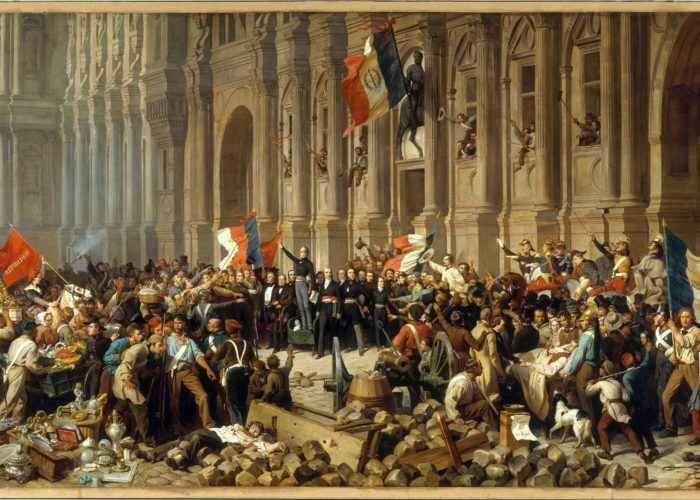Lamartine Rejetant le Drapeau Rouge (Lamartine Rejects the Red Flag): Painted by Felix Philippoteaux
In 1848, a wave of revolution spread from Paris across Europe. In France, the monarchy was finally overthrown once-and-for-all and the country became a republic once again. Alphonse de Lamartine played a leadership role in the provisional government and was instrumental in ensuring the Tricolore remained France’s national flag.
After the enormous and far-reaching impact of the French Revolution, the defeat of Napoleon, and the Congress of Vienna in 1815, a new order was imposed across Europe. In spite of harsh laws, many groups from lower and middling classes still campaigned for liberty, equality, and other rights – the freedom to live in a country of their own, to have a government of the people and for religious freedoms and freedom of the press. In 1848, huge unrest once again spread across the continent, though success was mixed and in many countries the political movements faltered in the face of concerted repression. In France, the monarchy was finally overthrown in what became known as the ‘February Revolution’, and the country became a republic for the second time – this time for good.
The years leading up to 1848 had seen rapidly increasing food prices and high unemployment. The people of the middle classes (known as the Bourgeoisie) began calling for reform, demanding fair wages and working conditions as well as an end to the high prices. In February 1848, they took to the streets of Paris, demanding the abdication of the King, Louis Philippe I. He abdicated on the 24th February and a provisional government was established to rule France. Alphonse de Lamartine (1790-1869), a writer, poet and Minister for Foreign Affairs whof social reform, took on many presidential duties. He proclaimed what became known as the ‘Second Republic’ in a famous speech from the balcony of the Hȏtel de Ville in Paris.
This painting shows Lamartine at the Hȏtel de Ville on the 25 February, rejecting the Red Flag of socialism as the new flag of France in place of the Tricolore of the First Republic. Though many revolutionaries preferred it and its longstanding connection to radical reform, for Lamartine and others, the Red Flag was a ‘blood’ flag, a symbol of anarchy which represented the threat of a workers’ republic, rather than a liberal democratic government. While Lamartine ruled France for just three months, the Tricolore remains the French national flag to this day.
Did you know..?
Alphonse de Lamartine famously said “History teaches everything, even the future”.
Sources & acknowledgements
This object description and its related educational resources were researched and written by our team of historians and education specialists. For further information see the item’s home museum, gallery or archive, listed above.
-
Did you know..?
Alphonse de Lamartine famously said “History teaches everything, even the future”.
-
Education overview
You can access a range of teachers resources related to this object and more on our education page.
Please also see our glossary of terms for more detailed explanations of the terms used.
-
Curatorial info
- Originating Museum: Petit Palais, Musée des Beaux-Arts de la Ville de Paris
- Accession Number: PDUT01468
- Production Date: 19th Century
- Creator: Felix Philippoteaux
-
Use this image
You can download this image for personal and educational use but please take note of the license type and rights holder information.
- Rights Holder: © Petit Palais / Roger-Viollet
- License Type: All Rights Reserved



